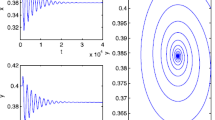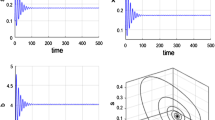Abstract
In this paper, a chemostat model with general monotone response functions and two discrete time delays is proposed to describe the dynamical behavior about predator–prey system. First, by analyzing the characteristic equation associated with the model, we obtain the conditions of the existence and stability of extinction equilibrium and positive equilibrium. Choosing delays as bifurcation parameters, the existence of Hopf bifurcations is investigated in detail. Second, by virtue of the Poincaré normal form method and center manifold theorem, explicit formulas are derived to determine the direction of Hopf bifurcation and the stability of the bifurcating periodic solutions. Finally, some numerical simulations are carried out to illustrate the theoretical results and the biological significance.




Similar content being viewed by others
References
Bush AW, Cool AE (1976) The effect of time delay and growth rate inhibition in the bacterial treatment of wastewater. J Theor Biol 63:385–395
Caperon J (1969) Time lag in population growth response of isochrysis galbana to a variable nitrate environment. Ecology 50:188–192
Celik C (2009) Hopf bifurcation of a ratio-dependent predator-prey system with time delay. Chaos Solitons Fract 42:1474–1484
Cooke KL, Driessche PVD (1986) On zeros of some transcendental equations. Funkcialaj Ekvacioj 29:77–90
Cunningham A, Maas P (1978) Time lag and nutrient storage effects in the transient growth response of Chlamydomonas reinhardii in nitrogen-limited batch and continuous culture. J Gen Microbiol 104:227–231
Deng L, Wang X, Peng M (2014) Hopf bifurcation analysis for a ratio-dependent predator-prey system with two delays and stage structure for the predator. Appl Math Comput 231:214–230
El-Owaidy HM, Ismail M (2002) Asymptotic behavior of the chemostat model with delay response in growth. Chaos, Solitons Fract 13:787–795
El-Owaidy HM, Moniem AA (2004) Global asymptotic behavior of a chemostat model with delayed response in growth. Appl Math Comput 147:147–161
El-Sheikh MMA, Mahrouf SAA (2005) Stability and bifurcation of a simple food chain in a chemostat with removal rates. Chaos Solitons Fract 23:1475–1489
Finn RK, Wilson RE (1954) Population dynamics of a continuous propagator for microorganisms. J Agric Food Chem 2:66–69
Gao S, Chen L, Teng Z (2008) Hopf bifurcation and global stability for a delayed predator-prey system with stage structure for predator. Appl Math Comput 202:721–729
Hassard BD, Kazarinoff ND, Wan YH (1981) Theory and applications of Hopf bifurcation, London mathematical society leture note series, vol 41. Cambridge University Press, Cambridge
Karaoglu E, Merdan H (2014) Hopf bifurcations of a ratio-dependent predator-prey model involving two discrete maturation time delays. Chaos Solitons Fract 68:159–168
Li B (1998) Global asymptotic behavior of the chemostat: general response functions and different removal rates. SIAM J Appl Math 59:411–422
Li BT, Kuang Y (2000) Simple food chain in a chemostat with distinct removals rates. J Math Anal Appl 242:75–92
Liu Q, Xu R (2011) Stability and bifurcation of a Cohen–Grosssberg neural network with discrete delays. Appl Math Comput 218:2850–2862
Macdonald N (1976) Time delay in simple chemostat models. Biotechnol Bioeng 18:805–812
Ncube I (2013) Absolute stability and Hopf bifurcation in a Plasmodium falciparum malaria model incorporating discrete immune response delay. Math Biosci 243:131–135
Qu R, Li X (2012) Hopf bifurcation of a chemostat model. Appl Math Comput 219:3541–3552
Ruan S, Wolkowicz GSK (1996) Bifurcation analysis of a chemostat model with a distributed delay. J Math Anal Appl 204:786–812
Smith HL, Waltman P (1995) The theory of the chemostat: dynamics of microbial competition. Cambridge University Press, Cambridge
Wang W, Ma Z (1999) Convergence in the chemostat model with delayed response in growth. Syst Sci Math Sci 12:23–32
Wang L, Wolkowicz GSK (2006) A delayed chemostat model with general nonmonotone response functions and differential removal rates. J Math Anal Appl 321:452–468
Wolkowicz GSK, Lu Z (1992) Global dynamics of a mathematical model of competition in the chemostat: general response funcions and differential death rates. SIAM J Appl Math 52:222–233
Wolkowicz GSK, Xia H (1997) Global asymptotic behavior of a chemostat model with discrete delays. SIAM J Appl Math 57:1019–1043
Yu W, Cao J (2005) Hopf bifurcation and stability of periodic solutions for van der Pol equation with time delay. Nonlinear Anal 62:141–165
Acknowledgements
The authors would like to thank the editor and referee for making the valuable suggestions to improve this paper. This research was supported by the Natural Science Foundation of Shanxi province (2013011002-2).
Author information
Authors and Affiliations
Corresponding author
Additional information
Communicated by Maurizio Grasselli.
This work is supported by the Natural Science Foundation of Shanxi province (2013011002-2).
Rights and permissions
About this article
Cite this article
Sun, S., Guo, C. & Liu, X. Hopf bifurcation of a delayed chemostat model with general monotone response functions. Comp. Appl. Math. 37, 2714–2737 (2018). https://doi.org/10.1007/s40314-017-0476-3
Received:
Revised:
Accepted:
Published:
Issue Date:
DOI: https://doi.org/10.1007/s40314-017-0476-3
Keywords
- Predator–prey system
- Discrete delay
- Monotone response functions
- Asymptotic stability
- Hopf bifurcation
- Periodic solution




